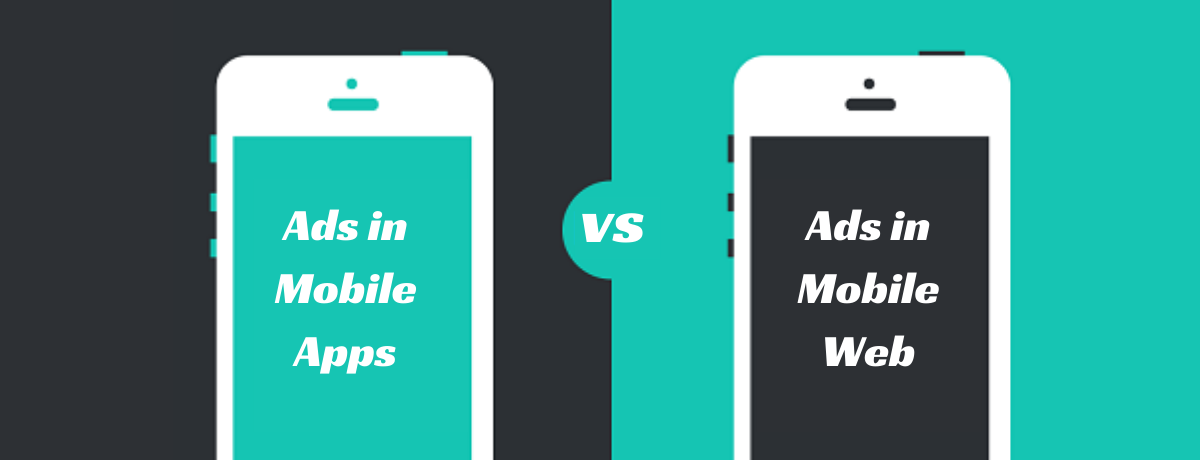
Deep Dive Analysis: Mobile Apps vs Mobile Web Placements
If you ever run a display campaign through Google Ads or any DSP with the objective to drive traffic or conversion, you’ve probably noticed a big difference in traffic performance driven by ads within mobile apps vs mobile web pages. If you realized this already, you’re probably wondering what you should do? Should you exclude all mobile apps? Should you target mobile apps for only branding campaigns?
Today, I will be explaining different approaches and metrics to evaluate the performance of ads in mobile apps vs mobile web pages. And when you should include or exclude a specific placement. So, before we get down to business, it’s worth mentioning that the stats you’ll see below are generated from Google Analytics for a display campaign that we ran recently for one of our clients.
Suspiciously High CTR
We’ve all accidentally clicked on ads within mobile apps or browsers, due to small screens or as they call it “fat finger” syndrome. There’s a recent survey conducted by retale.com claims that:
“60% of the mobile banner ad clicks are accidental”
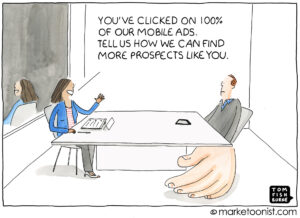
The fat finger problem applies to both mobile apps and mobile web placements. However, when we compared the CTR of mobile apps vs mobile web, the difference was significant. Mobile app ads had 129% higher CTR than ads in mobile web pages. Usually, the higher the CTR, the better. But in this case, the higher the CTR, the more accidental clicks you generate.
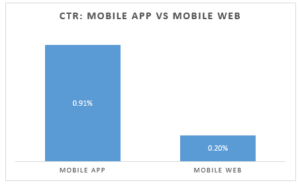
So, what happened? 🙄 There are many mobile apps designed in a way to trick users and gather accidental clicks. So, if you see a placement with a CTR higher than the average you usually see, it’s most probably a shady app that you must exclude.

9.22% CTR, are you kidding me? 😮 It’s even higher than some search campaigns.
High Session to Click Ratio
Yes, I can hear you 😀 , sessions and clicks never match due to the different processes of counting each. But, you should always pay attention to the ratio between sessions and clicks and always optimize towards lowering the difference.
When comparing the session to click ratio of mobile apps vs mobile web ads, we found out that 32% of mobile app clicks never translated into sessions versus 14% only of mobile web ads.
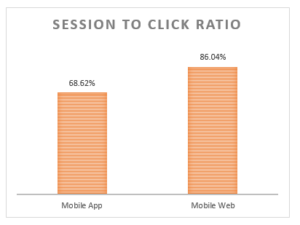
So, why mobile app ads have a lower session to click ratio? The answer is “short clicks”, the majority of the clicks driven by the mobile app ads were short clicks or in other words accidental clicks. A Short click occurs when a user clicks an ad, and then exits your website immediately before the Google Analytics tracking tag fires. Adwords records the click, but a corresponding session is not recorded in Analytics, which results in having more clicks than sessions.
How to know if the short clicks aren’t driven by your website speed?
If your website loads too slowly, you are not just losing a corresponding session to a click, but there is a possibility that users are leaving and going to your competitors, especially if competitors are able to deliver the same content quickly.
How to know the actual loading time for your GA tracking code?
Open an incognito window in chrome or clear your browser cache if you like, enter your website URL, right click anywhere on the page, and then choose “Inspect”.
Under the Network tab, search for “google-analytics” and look at the timeline section on the right-hand side.
![]()
In the example above, you can see that my website took 158 ms to load the Google Analytics tracking code which is amazing 😎 . If it happens and you see that the loading for your GA tracking code is greater than 3 seconds. This means if a user clicks the back button within these 3 seconds, Analytics may fail to record a session on this website, but Facebook will have recorded the click.
The solution here is to place the GA tag or the GTM container snippet as high in the HTML source before other scripts.
High Bounce Rate & Low Session Duration
Bounce rate and session duration can play a vital role in determining the quality of the driven traffic to the website. Of course, if there is a high volume of unintended clicks, this will be sharply reflected in so high bounce rate and low session duration.
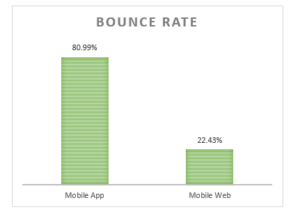
As you can see above, mobile app ads drove a 72% higher bounce rate than mobile web ads. I’d highly recommend comparing the results to the overall average you see on your website.
Summary
Before you jump and go evaluate the conversion performance of your mobile app ads, It’s recommended you to take a step back and review all the traffic-based metrics like (session, clicks, CTR, bounce rate). And starting weeding out all the placements that bring poor results. Afterward, you can deep dive into your conversion optimization framework.

Entrepreneur focused on building MarTech products that bridge the gap between marketing and technology. Check out my latest product GA4 Auditor and discover all my products here.
